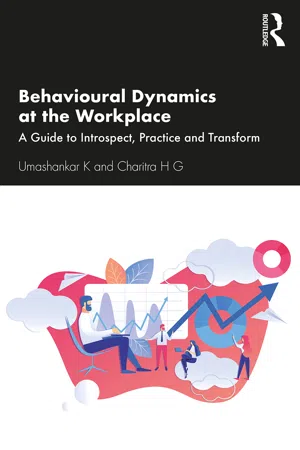1 A journey into self
Introduction to self
A long, long ago, not some time ago but quite some time ago, Lord Brahma (the Creator of the Universe according to Hindu Philosophy) created the Earth and germinated infinite forms of life on this Earth. At last, he wanted to crown the entire creation with a Divine form of life, so he created humans in his form. Mesmerized by the beauty and grandiosity of these humans, Lord Brahma showered all the blessings on these creatures in the form of intelligence, knowledge, braveness, courage and strength. Finally, he was about to bestow the last blessing, Happiness, on humans and he suddenly stopped. He knew that these humans had been blessed with all the virtues except Happiness and Life’s Purpose, and if he bestowed even this gift on these humans, they would be self-fulfilled and might stop working. Hence, he thought to hide Happiness somewhere in the distance so that humans would literally struggle to explore these virtues. Therefore, he called for a meeting of all gods and the agenda of the meeting was “Where to hide Happiness?”
As per the schedule, all the gods attended the meeting and started brainstorming as to where to hide Happiness. One god said that Happiness may be hidden on the pinnacle of a distant mountain and he also said that humans would exhaust themselves to explore the hidden Happiness. After listening to this suggestion, Brahma said, “You see … I have created these humans and I know what they are capable of. I can foresee their future. They take flight into the azure skies majestically and they also fathom the infinite Cosmos. The creatures that can majestically fly into the skies may not find it difficult to climb up the mountain and attain the hidden priceless bounty.” Therefore, the idea of hiding Happiness in the mountain was dropped and the brainstorming resumed.
One of the gods said, “Why can’t we hide Happiness in the underground?” The other god reprimanded, saying, “Have you lost your senses? Didn’t you listen to what Brahma said? These humans can fly like birds in the future and if these creatures can fly like birds in the skies, they can easily go into the underground and they can unleash the bounty.” After listening to this condemnation, the entire hall resonated with laughter and the brainstorming continued. As the brainstorming reached its peak, one of the most intelligent gods of Hindu mythology said in a shrewd voice, “As I see these humans, it gives me a strong feeling that these humans have the nature of monkeys. As monkeys are always restless and keep hopping from one branch to another, even these humans are always restless in trying to discover, invent and explore outside and they never find time to introspect into themselves. Therefore, it would be wise to hide Happiness in themselves so that they keep struggling to find that Happiness outside and they never get time to introspect into themselves.” All the gods including Lord Brahma were convinced about this idea and Lord Brahma hid Happiness in the humans’ ‘Self’.
This story is a perfect metaphor for the contemporary issues in understanding and managing ‘Self’. Besides, the story also compels the readers to contemplate various concerns like:
- What is Self?
- How is our Self formed?
- What factors influence our Self?
- What does our Self comprise?
- Why don’t we get time for self-introspection?
- How do we practice self-introspection?
- What is the role of our ‘Self’ in our career enhancement?
Definition of self and theories on self
Since the time immemorial, the term ‘Self’ has been widely critically evaluated by philosophers, scientists and psychologists. The philosophers like Plato, Aristotle and Kant defined ‘Self’ in transpersonal terms to mean an all-pervading entity that doesn’t have any physical form and transcends beyond the physical world. However, the soul is an intangible and subjective concept and it cannot be measured for accurate conclusions. During the later stage of intellectual evolution, there was a tremendous focus on studying human personality and behaviours. The psychologists focused on ‘Self’, the core of human personality that differentiates a person from others. Further, the psychologists developed their own theories to explain the subtle nature of the self (Figure 1.1).
Eric Berne’s theory: Dr Eric Berne, in 1958, proposed his theory called Transactional Analysis that was based on Freudian psychoanalysis. Berne believed that the human self is formed and nurtured in the midst of day-to-day social interactions. He inferred that the ‘Self’ is greatly influenced by the immediate surroundings like parents, siblings and peer groups, and the later stage, the social environment, also plays a crucial role on imprinting certain impressions on the human psyche. The impressions that an individual accumulates into his or her ‘Self’ condenses to form three ego states called Parent Ego, Adult Ego and Child Ego. The beauty of these ego st...
